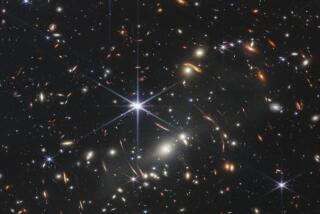ORIGINS The Possibilities of Science for the Genesis of Life on Earth <i> by Robert Shapiro (Summit: $16.95; 304 pp.) </i>
- Share via
“In the beginning the earth’s atmosphere contained methane, hydrogen, ammonia and water vapor.” So starts the most popular but probably not the most accurate account of the origin of life on Earth. If the hallmark of a living organism is the ability to reproduce and evolve, that is to successfully adapt to changing environments, then by what process did the first living organism come into being? The most repeated paradigm suggests that the primitive Earth had an atmosphere of methane, ammonia, hydrogen and water which when exposed to intense energy such as lightning, produced simple organic compounds, amino acids and nucleotides--the building blocks of proteins and DNA. Over a period of approximately 1 billion years, by mechanisms as yet unknown, these simple molecules reacted with each other to form larger and larger molecules that eventually became sequestered within an oily membrane and there began to reproduce themselves. (There is considerable debate concerning whether the first replicative forms were protein or nucleic acids, and Shapiro offers the pros and cons for each with considerable clarity.) During the subsequent 3.5 billion years, the evolution of such duplicating protocells resulted in the spectacular variety of life visible to us today.
There are alternative explanations to the origin of life, and in his book “Origins,” Robert Shapiro, a professor of chemistry at New York University, examines six such explanations in addition to the one mentioned. Some of the explanations are beyond the realm of science, such as the creation myth of the Eskimos and the biblical presentation of Genesis. Others involved the arrival of life from extraterrestrial sources. Perhaps life arrived in the form of bacteria or a virus riding on a beam of starlight or upon a comet! No single explanation is espoused by the author with particular fervor or missionary zeal. Instead, Shapiro attempts to examine each of the seven possibilities for the origin of life which he so deftly presents in his prologue. His narrative approach is that of a skeptical scientist asking: “What is the evidence, where is the supporting data?” His style is conversational and almost folksy--particularly in the chapter where he describes some of the interactions of the scientists gathered in Mainz, Germany, in 1983 at an international conference on the origins of life. The basic chemistry and cell biology necessary to understand the various experiments which have attempted to unravel the mystery of origins can be comprehended easily by the nonscientist. Moreover, his identification of the major proponents of each hypothesis and their placement in a historical context adds a dimension that seems to make the reading easier and to connect the disparate theories. In addition, the statistical arguments concerning the probability of certain chemical reactions occuring are presented by an inventive analogy to a multistory tower of numbers and by the familiar analogy to a chimpanzee writing Shakespearean sonnets.
In contrast to the notorious proclamation of Archbishop James Ussher of Trinity College in Dublin, who in 1650 declared that God made heaven and Earth on Saturday, Oct. 22, 4004 BC, most scientific evidence suggests the age of the Earth to be approximately 4.5 billion years. After approximately 1 billion years the first single-celled organism appeared. The question of how that first living cell arose should pique the interest of every thoughtful human being. Shapiro has written a wonderfully readable and sometimes highly critical analyses of the most prominent (not necessarily most plausible) explanation for the origin of that first cell which informs and occasionally entertains the reader and fulfills the author’s desire to instill “Not only a sense of wonder at the unsolved riddle of our existence but also a preference for doubt in place of dogma and a keen appreciation for the proper practice of science.”






